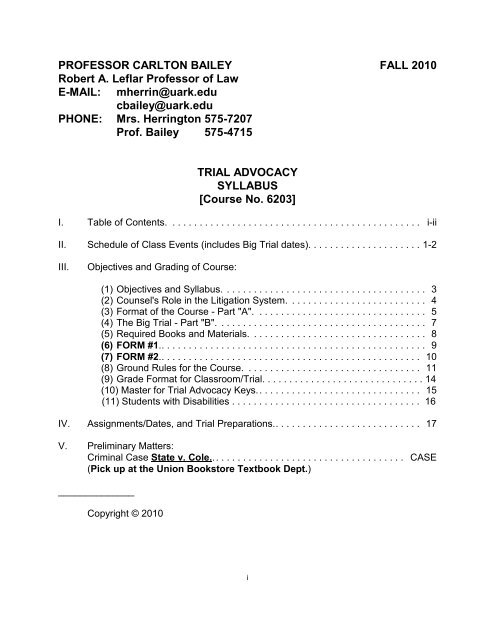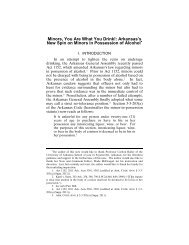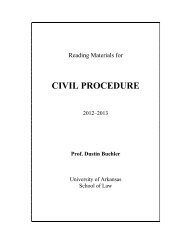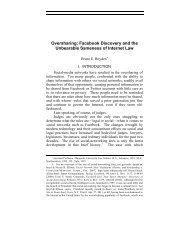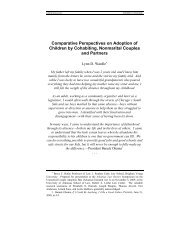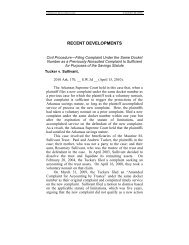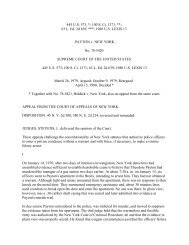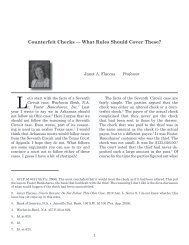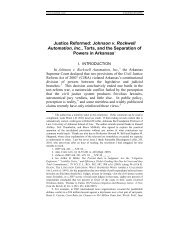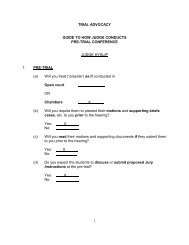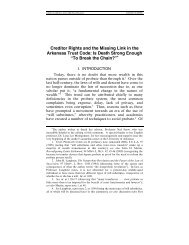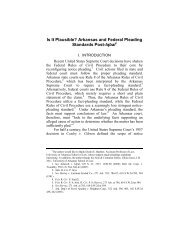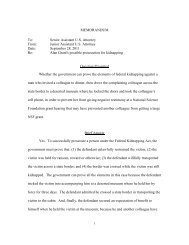TA-Syllabus - School of Law - University of Arkansas
TA-Syllabus - School of Law - University of Arkansas
TA-Syllabus - School of Law - University of Arkansas
You also want an ePaper? Increase the reach of your titles
YUMPU automatically turns print PDFs into web optimized ePapers that Google loves.
PROFESSOR CARLTON BAILEY FALL 2010<br />
Robert A. Leflar Pr<strong>of</strong>essor <strong>of</strong> <strong>Law</strong><br />
E-MAIL: mherrin@uark.edu<br />
cbailey@uark.edu<br />
PHONE: Mrs. Herrington 575-7207<br />
Pr<strong>of</strong>. Bailey 575-4715<br />
TRIAL ADVOCACY<br />
SYLLABUS<br />
[Course No. 6203]<br />
I. Table <strong>of</strong> Contents. .............................................. i-ii<br />
II. Schedule <strong>of</strong> Class Events (includes Big Trial dates). . . . . . . . . . . . . . . . . . . . . 1-2<br />
III. Objectives and Grading <strong>of</strong> Course:<br />
(1)Objectives and <strong>Syllabus</strong>...................................... 3<br />
(2) Counsel's Role in the Litigation System. . . . . . . . . . . . . . . . . . . . . . . . . . 4<br />
(3)Format <strong>of</strong> the Course - Part "A". ............................... 5<br />
(4)The Big Trial - Part "B". ...................................... 7<br />
(5)Required Books and Materials. ................................ 8<br />
(6) FORM #1.................................................. 9<br />
(7) FORM #2................................................. 10<br />
(8)Ground Rules for the Course. ................................ 11<br />
(9) Grade Format for Classroom/Trial. . . . . . . . . . . . . . . . . . . . . . . . . . . . . . 14<br />
(10) Master for Trial Advocacy Keys.. . . . . . . . . . . . . . . . . . . . . . . . . . . . . . 15<br />
(11) Students with Disabilities . . . . . . . . . . . . . . . . . . . . . . . . . . . . . . . . . . . 16<br />
IV. Assignments/Dates, and Trial Preparations.. . . . . . . . . . . . . . . . . . . . . . . . . . . 17<br />
V. Preliminary Matters:<br />
Criminal Case State v. Cole..................................... CASE<br />
(Pick up at the Union Bookstore Textbook Dept.)<br />
______________<br />
Copyright © 2010<br />
i
1. Opening Statement- Criminal Case State v. Cole........................ CASE<br />
2. Direct/Cross Examination- Criminal Case State v. Cole................... CASE<br />
(a) Key witness for the Plaintiff in State v. Cole<br />
(b) Key witness for the Defendant in Criminal CaseState v. Cole<br />
3. Closing Arguments - Criminal Case State v. Cole....................... CASE<br />
4. Plaintiff’s Team/Defendant’s Team - Appendix A. . . . . . . . . . . . . . . .. . . . . . . . 28-29<br />
5. Attorney Worksheet for the Pretrial Conference - Appendix B . . . . . . . . . . . . . . 30<br />
6. Representative Table <strong>of</strong> Contents for<br />
A Trial Notebook - Appendix C . . . . . . . . . . . . . . . . . . . . . . . . . . . . . . . . . . . . . . .31<br />
7. Books/Videos - Appendix D. . . . . . . . . . . . . . . . . . . . . . . . . . . . . . . . . . . . . . . . . 32-34<br />
8. Key to Each Exercise - Appendix E . . . . . . . . . . . . . . . . . . . . . . . . . . . . . . . . . . 35<br />
9. Planning for the Big Trial - Evidentiary<br />
Issues to Consider - Appendix F . . . . . . . . . . . . . . . . . . . . . . . . . . . . . . . . . . . . 36<br />
10.Key for Prep Sheets - Appendix G. . . . . . . . . . . . . . . . . . . . . . . . . . . . . . . . . . . 37<br />
11.Additional “Ground Rules” - Appendix H . . . . . . . . . . . . . . . . . . . . . . . . . . . . . . 38<br />
12. Anatomy <strong>of</strong> a Trial - Appendix I . . . . . . . . . . . . . . . . . . . . . . . . . . . . . . . . . . . . .39-40<br />
ii
TRIAL ADVOCACY - FALL 2010<br />
SCHEDULE OF CLASS EVENTS<br />
August 23 (Mon.) First Written Assignment - [Orientation]<br />
(meet student coordinators)<br />
August 24 (Tues.) Second Written Assignment<br />
“Short Form” motion due!<br />
1<br />
Courtroom 240<br />
See p. 17<br />
Courtroom 240<br />
See p. 18<br />
August 30 (Mon.) Third Written Assignment Courtroom 240<br />
See p. 19<br />
August 31 (Tues.) Fourth Assignment. Meeting with<br />
Pr<strong>of</strong>essor Bailey.<br />
September 2 (Thurs.) Special Written Assignment:: One<br />
Question due to Ms. Herrington in room 187<br />
by 3:00 p.m. See page 20.<br />
September 6 (Mon.) LABOR DAY HOLIDAY NO CLASS<br />
September 7 (Tues.) Fifth Assignment<br />
First meeting with Judges<br />
(Pretrial Conferences)<br />
September 13 (Mon.) Sixth Assignment<br />
(Critiques <strong>of</strong> Pretrials)<br />
September 14 (Tues.) Sixth Assignment continued<br />
(Opening Statement)<br />
September 20 & 21<br />
(Mon & Tues.)<br />
Seventh Assignment - Discuss critiques<br />
<strong>of</strong> Opening Statements and Direct by<br />
Prosecutor & Cross by Defendant<br />
September 22 (Wed.) Last Day to submit Name <strong>of</strong> Partner for<br />
the Big Trial to Ms. Herrington in room<br />
#187or by e-mail (mherrin@uark.edu)<br />
September 23 (Thurs.) Pairings e-mailed to list serv<br />
September 27 (Mon.) Last minute questions to Pr<strong>of</strong>essor Bailey<br />
and LOTTERY (one member from each team)!!<br />
Courtroom 240<br />
See p. 20<br />
See p. 21<br />
See p. 22<br />
See p. 22<br />
See p. 23<br />
COURTROOM 240
September 27 & 28<br />
(Mon. & Tues.)<br />
October 4 & 5<br />
(Mon. & Tues.)<br />
October 11 & 12<br />
(Mon. & Tues.)<br />
October 13<br />
(Wed.)<br />
October 18 & 19<br />
(Mon. & Tues.)<br />
October 25<br />
(Mon.)<br />
November 11<br />
(Thurs.)<br />
Eight Assignment - Discuss critiques <strong>of</strong><br />
Direct-X by Prosecutor and Cross-X by<br />
Defendants then Direct by Defense & Cross-X<br />
by Prosecutor<br />
Ninth Assignment - Judges provide Critiques <strong>of</strong><br />
Defendant’s Direct-X, etc.<br />
Closing Arguments.<br />
Tenth Assignment - Critique Closing Arguments.<br />
Arrange Pretrial Conferences for weeks <strong>of</strong> Oct.<br />
13th and 20th.<br />
Collect Instructions for the Big Trial from Mrs.<br />
Herrington in <strong>of</strong>fice #187. Last minute questions<br />
to Pr<strong>of</strong>. Bailey before Pretrials begin - <strong>of</strong>fice #315.<br />
Pretrials Begin! For day and times other than<br />
Monday/Tuesday class time, please arrange with<br />
your Judge or Ms. Herrington in <strong>of</strong>fice #187.<br />
(Pretrials continues).<br />
TRIALS BEGIN-FIRST TRIAL<br />
TRIALS END - LAST TRIAL<br />
2<br />
See p. 24<br />
See p. 25<br />
See p. 26<br />
PRETRIAL DATES: October 18 and 19 or at other mutually agreed upon times - during the<br />
Monday/Tuesday class hours.<br />
TRIAL DATES: October 25 Mon. (Trial #1)<br />
October 26 Tues. (Trial #2)<br />
October 27 Wed. (Trial #3)<br />
October 28 Thurs. (Trial #4)<br />
November 1 Mon. (Trial #5)<br />
November 2 Tues. (Trial #6)<br />
TRIAL TIME/PLACE: 4:10 to 7:30 P.M. — COURTROOM, ROOM 240.
A. The Importance <strong>of</strong> the Litigation System<br />
*<br />
OBJECTIVES AND SYLLABUS<br />
The Preamble to the United States Constitution lists, in part, the fundamental objectives <strong>of</strong><br />
an ordered society. The list <strong>of</strong> objectives includes "establishing justice and insuring domestic<br />
tranquility--" To achieve those objectives, the drafters established a government, including a<br />
judicial system described in Article III <strong>of</strong> the Constitution. The functions <strong>of</strong> that system are<br />
corollaries <strong>of</strong> the drafters' objectives: to dispense justice to litigants and to insure domestic<br />
tranquility by serving as a public mechanism for peaceful dispute resolution. As Hobbes wrote<br />
in the 17th century, when people feel free to resort to private, violent methods <strong>of</strong> dispute<br />
*<br />
resolution, "The life <strong>of</strong> man" is likely to be "poor, nasty, brutish, and short". In essence, an<br />
effective litigation system is a sine qua non for a just, orderly society. In our republic, the right<br />
<strong>of</strong> access to the litigation system is considered so valuable that the Supreme Court has<br />
elevated the right to constitutional status. **<br />
A. Castell, An Introduction To Modern Philosophy 360 (2d ed. 1963).<br />
** Bounds v. Smith, 430 U.S. 817 (1977); Boddie v. Connecticut, 401 U.S.<br />
371 (1971).<br />
3
COUNSEL'S ROLE IN THE LITIGATION SYSTEM<br />
Just as the litigation system serves a vital function with our society, so too does the<br />
attorney serve a critical role within that system. The primary conception <strong>of</strong> the trial attorney's<br />
role is that he functions as a representative <strong>of</strong> and an advocate for a client involved in litigation<br />
or anticipated litigation. The <strong>Arkansas</strong> Rules <strong>of</strong> Pr<strong>of</strong>essional Conduct in its preamble list the<br />
first role <strong>of</strong> counsel as that <strong>of</strong> a "representative <strong>of</strong> clients.” Such a representative, however,<br />
must be competent, because incompetent counsel can neither protect a client's interests nor<br />
help insure the effective operation <strong>of</strong> the system.<br />
The purpose <strong>of</strong> this course is to assist law students to become either competent trial<br />
counsel or competent assistants to competent trial counsel (or competent to determine when<br />
you're not competent). The Fall 2010 Trial Advocacy course will attempt to inculcate basic trial<br />
competencies by following a rigid schedule <strong>of</strong> assigned readings, brief lectures, video<br />
presentations, draftings, role plays, and critiques.<br />
4
PART "A"<br />
The class schedule is extremely tight. So there will be no opportunities to make up a missed<br />
assignment. A major objective <strong>of</strong> the course is to permit you to perform segments <strong>of</strong> and a<br />
full trial before NOVEMBER 11, 2010.<br />
FORMAT OF THE COURSE<br />
Three graded activities:<br />
1. Written preparatory assignments + Oral arguments - 10%<br />
2. Oral presentations - 40%<br />
3. Big Trial - 50%<br />
I. Written Preparatory Assignments, Practice Session and Critiques - 10% <strong>of</strong> Grade<br />
Each Student Must:<br />
(a) Attend All Classes (Any student who is over twenty (20) minutes late to<br />
class will be considered absent for that class!)<br />
(b) Read All Assignments - All students are required to read assignments from Mauet’s<br />
“Fundamentals <strong>of</strong> Trial Techniques” or “Trial Techniques.”<br />
(c) Prepare and Submit - Written assignments based on the reading assignments.<br />
Students are required to prepare and submit three (3) written<br />
assignments (including a “short form” motion!) to Pr<strong>of</strong>essor<br />
Bailey. These written assignments will be used to evaluate a<br />
student’s understanding <strong>of</strong> the (1) State v. Cole case (2)<br />
Federal Rules <strong>of</strong> Evidence; and (3) Principles from Mauet,<br />
and Rules <strong>of</strong> Pr<strong>of</strong>essional Conduct.<br />
II. Oral Classroom Assignment - 40% <strong>of</strong> Grade<br />
(a) FIVE (5) Graded Exercises: Pretrial Conf., Opening, Direct-X, Cross-X, Closing.<br />
(b) Before each graded exercise all students should prepare a one (1) page “prep” written<br />
outline or verbatim account <strong>of</strong> the questions, issues plans or strategies he/she intends to<br />
employ during that exercise. This written account should be based on the Pr<strong>of</strong>essor’s<br />
(or your Judge’s) lecture and the appropriate chapter(s) in Mauet See Appendix G at p.<br />
38 <strong>of</strong> this syllabus.<br />
(c) On the day <strong>of</strong> the exercise (usually on Tuesday), the Judge/Pr<strong>of</strong>essor will require each<br />
student to present the day's exercise. The pr<strong>of</strong>essor will serve as “Judge.”<br />
(d) At the next class day (usually the following Monday) the Judge/Pr<strong>of</strong>essor will critique<br />
5
(assess the good and bad points) <strong>of</strong> each student's performance. The Judge/Pr<strong>of</strong>essor<br />
shall <strong>of</strong>fer some “general” lessons or principles from the completed exercise.<br />
(e) This "exercise" performance at one class (Tuesday) then critique at the next class<br />
(Monday) format will be repeated until all FIVE EXERCISES have been completed.<br />
III. BIG TRIAL: 50% <strong>of</strong> Grade<br />
(a) Two - two-person teams will oppose each other in a Three (3) hour trial (State v. Cole).<br />
As a part <strong>of</strong> the team presentation, one student will be required to do an Opening while<br />
the other does a Closing. Then, each student must perform a Direct-X, Cross-X, and<br />
part <strong>of</strong> a Pretrial Conference. [There will be no Voir Dire during the Big Trial!]<br />
(b) At the end <strong>of</strong> the trial, the Judge will critique the student presentations.<br />
(c) A twelve (12) person jury will be required to complete a two-page evaluation <strong>of</strong> each<br />
student’s presentations. [The jury evaluations will not constitute any part <strong>of</strong> the final<br />
grade.]<br />
6
PART "B"<br />
THE BIG TRIAL<br />
(1) See p. 2 <strong>of</strong> the <strong>Syllabus</strong> for the Pretrial and Big Trial dates.<br />
(2) Trials begin MONDAY, OCTOBER 25, 2010.<br />
(3) Each Big trial team will consist <strong>of</strong> two partners. Students should submit both team<br />
members' names to Mrs. Herrington in a special envelope in her <strong>of</strong>fice #187, Leflar <strong>Law</strong><br />
Center no later than 2:00 p.m. on WEDNESDAY, SEPTEMBER 22, 2010.<br />
(4) Each trial will be preceded by a pretrial conference. Each team member will not only be<br />
graded on her/his performance during the 3-hour "Big Trial" but each will also be graded<br />
on the pretrial conference that precedes the Big Trial. Please dress pr<strong>of</strong>essionally for<br />
the “Big Trial” and the Pretrial Conference.<br />
EXTRA POINTS AFTER THE BIG TRIAL<br />
! TRIAL NOTEBOOK - IN ORDER TO RECEIVE CREDIT FOR A NOTEBOOK, IT MUST BE<br />
SUBMITTED TO MRS. HERRINGTON IN ROOM 187 BY 2:00 P.M. THE DAY AFTER THE<br />
TRIAL. [A TRIAL NOTEBOOK IS NOT A REQUIREMENT!]<br />
ONLY ONE notebook per team!! A notebook submitted after the deadline and to anyone<br />
other than Mrs. Herrington WILL NOT receive credit!!<br />
! See Form #2 - See p. 9 infra. - FINAL GRADE form from Classroom and the Big Trial.<br />
7
A. Required Books:<br />
REQUIRED BOOKS AND MATERIALS<br />
— Mauet “Fundamentals <strong>of</strong> Trial Techniques” OR “Trial Techniques”<br />
B. Required Course Materials:<br />
— <strong>Syllabus</strong> & Case Materials (Available at the Union Bookstore Textbook Department)<br />
— <strong>Arkansas</strong> Rules <strong>of</strong> Pr<strong>of</strong>essional Conduct<br />
— Federal Rules <strong>of</strong> Evidence<br />
— <strong>Arkansas</strong> Rules <strong>of</strong> Civil Procedure<br />
PLEASE READ THE "GROUND RULES" FOR THE COURSE (pp. 11-13 <strong>of</strong> <strong>Syllabus</strong>)<br />
AND CER<strong>TA</strong>IN RULES IN THE ARKANSAS RULES OF PROFESSIONAL CONDUCT<br />
(e.g. RULES 3.1 - 3.9).<br />
SUPPLEMEN<strong>TA</strong>RY BOOKS & <strong>TA</strong>PES<br />
— Bibliography <strong>of</strong> tapes and study aids in Appendix D.<br />
— Suggested Readings: Several copies in the library <strong>of</strong> Pr<strong>of</strong>essor Bailey’s materials located on<br />
the Reserve Shelf and on the Web.<br />
a. What <strong>Law</strong>yers Owe One Another<br />
b. <strong>Arkansas</strong> case - Lessenberry<br />
c. "They Don't Like What They Hear," an article taken from Legal Times (December 24,<br />
1990) about the D.C. Circuit’s increasing frustration with the lack <strong>of</strong> quality in oral<br />
advocacy before the courts.<br />
d. How to Prepare a Motion<br />
e. Pretrial Conference Order<br />
f. Stipulations<br />
g. Trial Notebook<br />
h. The American Board <strong>of</strong> Trial Advocates Civility Code.<br />
— Videotapes <strong>of</strong> student-conducted Pretrials<br />
8
TO WHOM IT MAY CONCERN:<br />
FORM NO. 1<br />
I, , consent to the use <strong>of</strong> audio or video recordings <strong>of</strong> my<br />
presentations in the Trial Advocacy course at the <strong>University</strong> <strong>of</strong> <strong>Arkansas</strong> <strong>Law</strong> <strong>School</strong>. I understand<br />
that the recorded presentations and transcripts there<strong>of</strong> will be used for educational purposes at the<br />
<strong>Law</strong> <strong>School</strong> and that only those authorized will be allowed to utilize said video or audio records and<br />
transcripts.<br />
SIGNED<br />
DATE<br />
9
Student's Name:<br />
Critiques<br />
Prep Sheets<br />
CLASSROOM GRADE:<br />
GRADE SCALE<br />
93-100 = A<br />
90-92 = A-<br />
88-89 = B+<br />
83-87 = B<br />
80-82 = B-<br />
TRIAL ADVOCACY<br />
FALL 2010<br />
FORM #2<br />
FINAL GRADE<br />
(Class and Big Trial)<br />
Pretrial Opening Direct Cross X Closing Total Points<br />
10<br />
TO<strong>TA</strong>L: (÷ 5)<br />
(1) Classroom Exercises (5) (as shown above) (40%) =<br />
(2) Classroom Written Assignments (10%) =<br />
(3) Total (50%)<br />
BIG TRIAL GRADE:<br />
(a) Trial Grade (50%)<br />
(b) Extra Points Notebook<br />
(c) Total 50% = + =<br />
GRAND TO<strong>TA</strong>L<br />
Numerical Grade Letter Grade
GROUND RULES FOR THE COURSE<br />
1. Preparation and Background Materials for Classroom Participation<br />
Each student is required to make at least FIVE (5) videotaped oral presentations in order to<br />
satisfy a portion <strong>of</strong> his/her classroom component grade. See Grade Key at page 14. Before<br />
each student performance, your instructor will assign appropriate chapters from Mauet as<br />
background reading for the upcoming exercise. (For instance, see Reading Assignment for<br />
the first oral presentation at page 21 “Pretrial Conference.”)<br />
In addition to the assigned chapters from Mauet, your instructor will present a short lecture<br />
and invite classroom discussion on that scheduled exercise. The research assignments for<br />
classroom discussion and the discussions based on them will be considered as part <strong>of</strong> the<br />
10% component to the classroom grade average.<br />
Student's Name<br />
Grade Form for Classroom Component<br />
(1) (a) Oral exercise #1 )<br />
(b) Oral exercise #2 )<br />
(c) Oral exercise #3 ) 40%<br />
(d) Oral exercise #4 )<br />
(e) Oral exercise #5 )<br />
(2) (a) First written assignment )<br />
(b) Second written assignment ) 10%<br />
(c) Third written assignment )<br />
2. Student preferences will be observed in assigning partners for the Big Trial. Students<br />
desiring to work together at the Big Trial should advise Pr<strong>of</strong>essor Bailey as soon as<br />
possible (or no later than WEDNESDAY, SEPTEMBER 22, 2010).<br />
3. Unless otherwise indicated, each case (in the simulated class exercises) is pending or is to<br />
be filed or has been filed in the courts <strong>of</strong> Washington County.<br />
4. The applicable rules <strong>of</strong> civil procedure are the same as the <strong>Arkansas</strong> Rules <strong>of</strong> Civil<br />
Procedure, (<strong>Arkansas</strong> Rules), with such modifications as are necessary to make them<br />
11
applicable in NI<strong>TA</strong>. You should be thoroughly familiar with the rules affecting trial and<br />
pretrial procedures, and especially the rules dealing with depositions.<br />
United States Supreme Court Opinions -Constitutional Criminal Procedure should be<br />
consulted as the need warrants!<br />
5. All classroom participation assignments and the Big Trial follow the Federal Rules <strong>of</strong><br />
Evidence.<br />
6. Unless otherwise indicated, assume that the only available witnesses who can give<br />
admissible testimony are those disclosed in the file materials distributed with the<br />
assignment. If you wish to use other testimony, which you consider would surely be<br />
available in such a case as the one on trial, ask the instructor before the class meeting for<br />
permission to assume the availability <strong>of</strong> such testimony.<br />
7. All students, whether called on to participate in an oral presentation as counsel or not, may<br />
be asked during a subsequent class how he/she would have handled some particular aspect<br />
<strong>of</strong> an exercise. The student questioned in this manner must answer orally or as otherwise<br />
instructed regarding the following issues: (1) the theory <strong>of</strong> the client's case (its strength and<br />
weakness); (2) the objectives in that phase <strong>of</strong> trial and how those objectives relate to the<br />
theory <strong>of</strong> the case (overall plan for trial); (3) any risks in the case, and (4) the applicable<br />
[Federal Rules <strong>of</strong> Evidence].<br />
8. Assume that all parties have been given due notice <strong>of</strong> the taking <strong>of</strong> any deposition that<br />
appears in the course materials.<br />
9. At times, for tactical reasons, a student may decide not to make a valid objection to<br />
evidence. In all such instances, the student should make a note immediately and be<br />
prepared to state during the instructor's evaluation <strong>of</strong> that performance why valid objections<br />
were not made. Moreover, after the class assignment, the student should give a copy <strong>of</strong><br />
his/her "non-objections" to the instructor.<br />
10. Conversely, at times a student may make a legally valid objection in carrying out his/her<br />
theory that he/she later regards as tactically unwise. The student should be prepared during<br />
a subsequent class or critique session to indicate such occasions with reasons for believing<br />
them tactically unwise.<br />
11. In some assignments, counsel may decide that the tactically correct examination would be<br />
short or nonexistent. Even so, a student may wish to conduct a longer examination in order<br />
to gain experience. That student should indicate this desire by a note to the instructor. If<br />
time allows, the instructor may then permit the student to conduct the longer examination.<br />
12. To conserve time for critique, the trial judge may interrupt proceedings during any student<br />
presentation and instruct counsel to summarize one or more elements <strong>of</strong> the planned<br />
examination. In that event, the instructor may also call on opposing counsel to indicate what<br />
objections, if any, she would have made.<br />
12
13. The roles <strong>of</strong> court reporter and bailiff will be performed by students. The instructor will<br />
designate a court reporter and a court clerk (or a single individual to play the role <strong>of</strong> a clerkreporter).<br />
14. Most statements <strong>of</strong> witnesses, in this handout and in the special materials, are typewritten<br />
for legibility. The signature should be assumed to be the handwritten signature <strong>of</strong> the<br />
witness. All photographs and letters should be considered originals.<br />
15. DATES OF RECENT EVENTS IN THESE MATERIALS ARE FREQUENTLY S<strong>TA</strong>TED IN A<br />
DATING CASE IN WHICH 19Y1 (OR -1) MEANS ONE YEAR AGO, 19Y2 MEANS TWO<br />
YEARS AGO, 19Y3 MEANS THREE YEARS AGO, AND SO ON. PLEASE CORRECT TO<br />
THE APPROPRIATE YEAR.<br />
16. In the event <strong>of</strong> a conflict between a ground rule and any special instruction in the assignment<br />
book, the special instruction governs; but, to be safe, discuss with the instructor.<br />
13
GRADE FORMAT FOR CLASSROOM/TRIAL<br />
GRADING KEY<br />
90 - 100 A- to A<br />
80 - 89 B- to B+<br />
70 - 79 C- to C+<br />
60 - 69* D- to D+<br />
(ALTHOUGH I HAVE NEVER GRADED BELOW A D-, I RESERVE<br />
THE RIGHT TO "AWARD" A FAILING GRADE TO ANY STUDENT<br />
WHO DESERVES IT)<br />
CLASSROOM PARTICIPATION - GRADE FORMAT<br />
Comments: Generally your performance was (poor), (satisfactory-average),<br />
(good), or (excellent).<br />
Poor = 60-69<br />
Average = 70-79<br />
Good = 80-89<br />
Excellent = 90-100<br />
(1) Salient issues in the exercise.<br />
(2) Issues student presented.<br />
(3) Quality <strong>of</strong> execution.<br />
(4) Significant issues missed.<br />
TIP: If quality <strong>of</strong> execution is poor and significant issues are missed, students are likely to score in<br />
the low average range or the mid-poor range.<br />
14
MASTER FOR TRIAL ADVOCACY KEYS<br />
CLASSROOM PARTICIPATION<br />
Knowledge <strong>of</strong> class objectives - 25 points<br />
Quality <strong>of</strong> preparation - 25 points<br />
Extent and quality <strong>of</strong> participation - 25 points<br />
Creativity - 25 points<br />
WRITTEN ASSIGNMENTS<br />
Recognition <strong>of</strong> assignment objectives - 25 points<br />
Quality <strong>of</strong> preparation - 25 points<br />
Clarity and organization <strong>of</strong> product - 25 points<br />
Creativity (unique interpretation, etc.) - 25 points<br />
PRETRIAL<br />
Display knowledge regarding facts and law<br />
Effective motions and arguments<br />
Effective preservation <strong>of</strong> the record<br />
Establish general ground rules for the trial<br />
OPENING S<strong>TA</strong>TEMENTS<br />
Introduction (i.e., parties, scene, instrumentalities, etc.) - 20 points<br />
Clear statement <strong>of</strong> relevant issues - 20 points<br />
Statement <strong>of</strong> the case - 20 points<br />
Conclusions/damages (civil case only) - 20 points<br />
Manner and style <strong>of</strong> delivery - 20 points<br />
DIRECT-EXAMINATION<br />
Introduction - 20 points<br />
Tell a story (develop facts) - 20 points<br />
Let witness dominate - 20 points<br />
Exhibits (use <strong>of</strong>) - 20 points<br />
Style, demeanor, objections, responses - 20 points<br />
CROSS-EXAMINATION<br />
Beginning/middle/conclusion - 20 points<br />
Control witness - 20 points<br />
Style and demeanor - 20 points<br />
Evidence and objections - 20 points<br />
Confirming points for your case - 20 points<br />
CLOSING<br />
Introduction - 20 points<br />
Statement <strong>of</strong> key jury instructions - 20 points<br />
Resolve issues, style and demeanor - 20 points<br />
Conclusion - 20 points<br />
Rebuttal - 20 points<br />
15
STUDENTS WITH DISABILITIES<br />
Students with disabilities, whether physical, learning, or psychological, who believe that they<br />
may need accommodations in this class, are encouraged to contact the<br />
Center for Students with Disabilities<br />
ARKU 104<br />
Fayetteville, AR 72701<br />
(479) 575-3104 (voice)<br />
(479) 575-3646 (TTY)<br />
ada@uark.edu<br />
web: http://www.uark.edu/edu/us/csd/<br />
as soon as possible to ensure that such accommodations are implemented in a timely fashion.<br />
Please meet with CSD staff to verify your eligibility for any classroom accommodations and for<br />
academic assistance related to your disability.<br />
16
ASSIGNMENTS - Fall 2010<br />
FIRST WRITTEN ASSIGNMENT - Monday, August 23 - ORIEN<strong>TA</strong>TION!<br />
PLACE: Courtroom 240<br />
ALL STUDENTS FIRST WRITTEN ASSIGNMENT!!<br />
A. Read the State v. Cole case - (Pick up at the Union Bookstore Textbook Dept.). Also see Mary<br />
Herrington to pick-up <strong>Syllabus</strong>.<br />
B. Read Mauet - Chapters 1 and 2.<br />
C. Read pp. 1-16 <strong>of</strong> the <strong>Syllabus</strong>! (particularly pp. 11 - 13!).<br />
D. Read “Overhead Notes for Trial Advocacy”, Spring 2010-Pr<strong>of</strong>essor Bailey’s Web page for Trial<br />
Advocacy (#55).<br />
E. PROSECUTOR TEAMS* - See APPENDIX A, pp. 28-29.<br />
1. Prepare a one (1) page (no more) memorandum identifying:<br />
(Submit the following to Pr<strong>of</strong>essor Bailey upon entering class.)<br />
__ The necessary elements supporting the PROSECUTOR’S case-in-chief in<br />
State v. Cole;<br />
— The key witness for the PROSECUTOR’S case-in-chief;<br />
— The weakest aspect <strong>of</strong> the PROSECUTOR’S case-in-chief;<br />
— One concern you have about the case that you wish to discuss with the -Chief Prosecutor-<br />
Pr<strong>of</strong>. Bailey. Why is this a concern for you?<br />
F. DEFENSE TEAMS* - See APPENDIX A, pp. 28-29.<br />
1. Prepare a one (1) page (no more) memorandum identifying:<br />
(Submit the following to Pr<strong>of</strong>essor Bailey upon entering class.)<br />
— The necessary elements supporting S<strong>TA</strong>TE v. COLE defense;<br />
— The key witness for S<strong>TA</strong>TE v. COLE;<br />
— The weakest aspect <strong>of</strong> the defense;<br />
— One concern you have about the case that you wish to discuss with Senior Partner- Pr<strong>of</strong>.<br />
Bailey. Why is this a concern for you?<br />
* See APPENDIX A, pp. 28-29 for Classroom Team Designations and name <strong>of</strong> judge.<br />
17
ASSIGNMENTS - Fall 2010<br />
SECOND WRITTEN ASSIGNMENT - Tuesday, August 24<br />
PLACE: Courtroom 240<br />
ALL STUDENTS - TEAMS<br />
A. Read Mauet - Chapters 2 and 3.<br />
B. Read the State v. Cole case.<br />
C. See Pretrial Conference Order on Reserve Shelf in the <strong>Law</strong> Library.<br />
D .PROSECUTOR TEAMS* - See APPENDIX A, pp. 28-29.<br />
Submit to Pr<strong>of</strong>. Bailey at class time a two page (no more) memorandum (keep a copy for purposes<br />
<strong>of</strong> #3 below) which should cover the following:<br />
I. Identify one fact that the PROSECUTOR may wish to persuade the defense to stipulate to that<br />
might simplify the issues in State v. Cole this case. (See stipulation cases on the Web).<br />
2. Identify three (3) issues that the PROSECUTOR should request the court to resolve before trial.<br />
Identify a (only one (1)) Rule <strong>of</strong> Evidence that supports each issue.<br />
3. Submit a short form motion (example on the Web) and be prepared to orally argue to the<br />
court (Pr<strong>of</strong>. Bailey) for the exclusion <strong>of</strong> any (only one!) item <strong>of</strong> evidence that supports your<br />
theory or that undermine’s your adversary’s theory.<br />
E. DEFENSE TEAMS* - See APPENDIX A, pp. 28-29.<br />
Submit to Pr<strong>of</strong>. Bailey at class time a two-page (no more) memorandum (keep a copy for purposes<br />
<strong>of</strong> #3 below) which should cover the following:<br />
1. Identify one fact that the Defense may persuade the State to stipulate to that could simplify the<br />
issues in the State v. Cole case. (See stipulation cases on the Web).<br />
2. Identify three (3) issues that the Defense should request the court to resolve before trial. Identify<br />
a (only one (1)) Rule <strong>of</strong> Evidence that supports each issue.<br />
3. Submit a short form motion ( an example is on the Web) and be prepared to orally argue to the<br />
court (Pr<strong>of</strong>. Bailey) for the exclusion <strong>of</strong> any (only one!) item <strong>of</strong> evidence that supports the<br />
defense’s theory or that undermines the Prosecutor’s theory.<br />
* See APPENDIX A, pp. 28-29 for Classroom Team Designations and name <strong>of</strong> judge.<br />
18
ASSIGNMENTS - Fall 2010<br />
THIRD WRITTEN ASSIGNMENT - Monday, August 30 and Tuesday, August 31<br />
PLACE: Courtroom 240<br />
[ALL STUDENTS - TEAMS]<br />
A. Read Mauet - Chapters 3, 4, 5, 6 & 8.<br />
B. Read the State v. Cole case.<br />
C. PROSECUTOR TEAMS* - See APPENDIX A - pp. 28-29.<br />
Submit to Pr<strong>of</strong>essor Bailey at class time a one-page (no more) memorandum identifying:<br />
1. Two (2) points that the Prosecutor must raise during its opening statement.<br />
2. Assume that the Defendant has asserted a SODDI defense. In twenty-five (25) words or<br />
less, what argument under the Federal Rules <strong>of</strong> Evidence is more likely to persuade the<br />
trial judge to disallow this defense?<br />
3. One key exhibit necessary to prove an element <strong>of</strong> the PROSECUTOR’s case-in-chief.<br />
What rule or rules <strong>of</strong> evidence will govern the admissibility <strong>of</strong> this exhibit?<br />
4. One key portion <strong>of</strong> the key witness’s testimony that you should be prepared to protect<br />
him/her on during the Defense’s cross examination.<br />
D. DEFENDANT TEAMS* - See APPENDIX A - pp. 28-29.<br />
Submit to Pr<strong>of</strong>essor Bailey at class time a one-page memorandum identifying:<br />
1. Two (2) points that the Defendant must raise during its opening statement.<br />
2. Assume that the Defendant asserted a SODDI defense. In twenty-five (25) words or less,<br />
what argument under the Federal Rules <strong>of</strong> Evidence is more likley to persuade the trial<br />
judge to allow this defense?<br />
3. One key exhibit that is supportive <strong>of</strong> the Defendant’s theory. What rule or rules <strong>of</strong><br />
evidence will govern the admissibility <strong>of</strong> this exhibit?<br />
4. One key portion <strong>of</strong> the Defendant’s key witness’s testimony that you should be<br />
prepared to protect him/her on during the Prosecutor’s cross examination.<br />
E. SPECIAL WRITTEN ASSIGNMENT: For both teams due to Ms. Herrington in <strong>of</strong>fice #187 no<br />
later than Thursday, September 2, 2010 at 3:00 p.m. See next page (#20) Part C for full<br />
instructions.<br />
* See APPENDIX A, pp. 28-29 for Classroom Team Designations and name <strong>of</strong> judge.<br />
19
ASSIGNMENTS - Fall 2010<br />
FOURTH ASSIGNMENT - Monday, September 6 (LABOR DAY - NO CLASS)<br />
Special Instructions for a Special Writing Assignment due on<br />
September 2, 2010, see below.<br />
PLACE: Courtroom 240<br />
A. Consult Mauet - Do you have questions? Then see Pr<strong>of</strong>essor Bailey.<br />
B. Read the State v. Cole case - Do you have questions? Then see Pr<strong>of</strong>essor Bailey.<br />
C. In preparation for your first meeting with the judges (Tuesday, September 7, 2010) each<br />
student (both teams) is required to pose one (1) (only one!)** written question to Pr<strong>of</strong>essor<br />
Bailey regarding any one <strong>of</strong> the following matters: the course, the syllabus, State v. Cole,<br />
the previous written assignments, the upcoming pretrial or whatever. This question should be<br />
submitted to Ms. Herrington in <strong>of</strong>fice #187 no later than 3:00 p.m. on Thursday, September<br />
2, 2010.<br />
D. PROSECUTOR’S TEAMS* - See APPENDIX A - pp. 28-29.<br />
Submit questions to Pr<strong>of</strong>essor Bailey before or at class time regarding any aspect <strong>of</strong> the<br />
course. (Particularly, in the “I STILL DON’T GET....” file folder!)<br />
1. Present questions to Pr<strong>of</strong>essor Bailey about the course, etc.<br />
2. Prepare for first meeting with Judge - Tuesday, September 7, 2010!<br />
E. DEFENSE TEAMS* - See APPENDIX A, pp. 28-29.<br />
Submit questions to Pr<strong>of</strong>essor Bailey before or at class time regarding any aspect <strong>of</strong> the<br />
course. (Particularly, in the “I STILL DON’T GET....” file folder!)<br />
1. Present questions to Pr<strong>of</strong>essor Bailey about the course, etc.<br />
2. Prepare for first meeting with Judge - Tuesday, September 7, 2010!<br />
F. Since the PROSECUTOR’s and Defense attorneys will be meeting at a Pretrial Conference<br />
before a Judge on Tuesday, September 7, 2010, each side should:<br />
1. (Prior to this pretrial conference) meet outside <strong>of</strong> class and stipulate (agree not to contest at<br />
trial) to certain facts or issues that will facilitate an efficient and uninterrupted trial.<br />
Prosecutor and Defense attorneys should not, however, weaken their side’s case by<br />
stipulating;<br />
2. Prosecutor and Defense attorneys should give his/her opponent [at least] 48 hours written<br />
notice <strong>of</strong> what issues he/she will argue at the Pretrial Conferences on Tuesday,<br />
September 8, 2010; and<br />
3. All stipulated matters must be reduced to writing and signed by the Prosecutor’s and the<br />
Defense attorneys. A copy <strong>of</strong> those written stipulations should be presented to the Judge at<br />
the Pretrial Conferences on Tuesday, September 7, 2010.<br />
**All other questions must be personally presented to Pr<strong>of</strong>essor Bailey in his <strong>of</strong>fice #315.<br />
* See APPENDIX A, pp. 28-29 for Classroom Team Designations and name <strong>of</strong> judge.<br />
20
ASSIGNMENTS - Fall 2010<br />
FIFTH ASSIGNMENT - Monday, September 6 NO CLASS (<strong>University</strong> Closed)<br />
Tuesday, Sept. 7 Pretrial Conferences!!<br />
PLACE: Hyslip - Courtroom<br />
Durrett - Room 339<br />
Threet - Room 342<br />
PROSECUTOR AND DEFENSE TEAMS:<br />
A. Read Mauet - Chapter 1.<br />
B. Read Ark. R. Civ. p. 16 and Ark. R. Crim. p. 20.1-10.4.<br />
C. See Stipulation Cases on the Web.<br />
D. Read State v. Cole case.<br />
1. MONDAY, SEPTEMBER 6, 2010 - NO CLASS!<br />
2. See previous page (20) for additional written assignment-to submit to Ms. Herrington in<br />
<strong>of</strong>fice #187.<br />
3. TUESDAY, SEPTEMBER 7, 2010 - Pretrial Conferences: During the pretrial conference<br />
in the State v. Cole case, each student from the Prosecutor’s side and each from the<br />
Defense’s side will meet with the judge in “chambers” and discuss those matters usually<br />
covered at a pretrial conference (see Pretrial Conference Order on Reserve Shelf in the<br />
<strong>Law</strong> Library, Ark. R. Civ. p. 16 and Ark. R. Crim. p. 20.4). Each student will have<br />
approximately TEN MINUTES to present his/her issues at the conference.<br />
3. The judge will select one <strong>of</strong> the two attorneys to prepare a pretrial order based on the<br />
judge’s orders and the party’s agreements at the pretrial conference <strong>of</strong> TUESDAY,<br />
SEPTEMBER 7, 2010.<br />
The student attorney who was not selected to draft the pretrial order will be responsible for<br />
reviewing and editing the selected party’s draft order. After the order has been reviewed<br />
and edited, both attorneys will sign their names to the completed order. The signed order<br />
shall be presented to the judge at the class hour on MONDAY, SEPTEMBER 13, 2010.<br />
* See APPENDIX A, pp. 28-29 for Classroom Team Designations and name <strong>of</strong> judge.<br />
21
ASSIGNMENTS - Fall 2010<br />
SIXTH ASSIGNMENT - Monday, September 13 and Tuesday, September 14<br />
PLACE: Hyslip - Courtroom 240<br />
Durrett - Room 339<br />
Threet - Room 342<br />
PROSECUTOR AND DEFENSE TEAMS:<br />
A. Read Mauet - Chapters 3.<br />
B. Read the Pretrial Conference Order in State v. Cole case.<br />
C. Read the Ground Rules for the Course.<br />
D. Read the State v. Cole case.<br />
1. MONDAY, SEPTEMBER 13, 2010 - All students (both Prosecutor’s and Defense* teams)<br />
must meet with the judges to discuss critiques <strong>of</strong> the pretrial conferences in the State v.<br />
Cole case.<br />
2. TUESDAY, SEPTEMBER 14, 2010 - Each student from the Prosecutor’s side and each<br />
student from the Defense side will present opening statements in the State v. Cole case.<br />
Each student will have approximately TEN MINUTES to complete his or her opening<br />
statement. (Please present pretrial order to the judge-if you did not submit to the Judge on<br />
September 13, 2010).<br />
* See Appendix A, pp. 28-29 for Classroom Team Designations and name <strong>of</strong> appropriate judge.<br />
22
ASSIGNMENTS - Fall 2010<br />
SEVENTH ASSIGNMENT - Monday, September 20 and Tuesday, September 21<br />
PLACE: Threet - Courtroom 240<br />
Durrett - Room 339<br />
Hyslip - Room 342<br />
PROSECUTOR AND DEFENSE TEAMS:*<br />
A. Read Mauet - Chapters 4, 5, 6 & 8.<br />
B. Read the Pretrial Conference Order in the State v. Cole case.<br />
C. Read the Ground Rules for the Course.<br />
1. MONDAY, SEPTEMBER 20 and TUESDAY, SEPTEMBER 21 - All students must meet with<br />
Judges to discuss the critiques <strong>of</strong> Opening Statements in the State v. Cole case.<br />
2. TUESDAY, SEPTEMBER 21, 2010 - Each student from the Prosecutor’s side will conduct a<br />
Direct Examination <strong>of</strong> his/her key witness. Although each student should prepare a full<br />
Direct Examination, he or she will be given only TEN MINUTES to conduct the Direct<br />
Examination.<br />
3. Each student from the Defense side will conduct a Cross Examination <strong>of</strong> the Prosecutor’s<br />
witness. Although each defense attorney should prepare a full Cross Examination; he/she will<br />
be given only FIVE MINUTES to conduct the Cross Examination.<br />
4. WEDNESDAY, SEPTEMBER 22, 2010 - FINAL DAY (2:00 P.M.) TO SUBMIT NAME OF<br />
PARTNER TO MRS. HERRINGTON. AN ENVELOPE WITH THE HEADING “PARTNERS<br />
FOR BIG TRIAL” WILL BE AVAILABLE IN MRS HERRINGTON’S OFFICE, ROOM 187.<br />
5. THURSDAY, SEPTEMBER 23, 2010 - The pairings for the Big Trial (e.g., who will be<br />
Prosecutor’s and their respective defense attorney-opponents) will be e-mailed to the<br />
students. There shall be two (2) attorneys on each team. All four (4) attorneys should meet<br />
on the weekend <strong>of</strong> FRIDAY, SEPTEMBER 24 AND SATURDAY, SEPTEMBER 25 to decide<br />
the date <strong>of</strong> the trial, and the name <strong>of</strong> the judge the group prefers. All selections will be by<br />
LOTTERY. One representative from the four-person weekend discussion group should come<br />
to the Courtroom at class time on MONDAY, SEPTEMBER 27, 2010 to select a Lottery<br />
Number (1-5). The lowest pick (#1) will select first. Selections will take place in the<br />
Courtroom on MONDAY, SEPTEMBER 27, 2010.<br />
* See APPENDIX A, pp. 28-29 for Classroom Team Designations and name <strong>of</strong> appropriate judge.<br />
23
ASSIGNMENTS - Fall 2010<br />
EIGHTH ASSIGNMENT - Monday, September 27 and Tuesday, September 28<br />
PLACE: Durrett - Courtroom 240<br />
Threet - Room 339<br />
Hyslip - Room 342<br />
PROSECUTOR AND DEFENSE TEAMS*<br />
A. Read Mauet - Chapters 4, 5, 6 & 8.<br />
B. Read the Pretrial Conference Order in the State v. Cole case.<br />
C. Read the Ground Rules for the Course.<br />
1. MONDAY, SEPTEMBER 27, 2010 - All students (both Prosecutor’s* and Defense* teams) must<br />
meet with the judge to discuss critiques <strong>of</strong> opening statements in the State v. Cole case,<br />
LOTTERY IN THE COURTROOM TODAY!<br />
2. MONDAY, SEPTEMBER 27, 2010 - All students (both Prosecutor’s* and Defense* teams) must<br />
meet with the judges to discuss the critiques <strong>of</strong> PROSECUTOR’s Direct and Defendant’s Cross<br />
Examination.<br />
3. TUESDAY, SEPTEMBER 28, 2010 - Each student from the Defense side will conduct a Direct<br />
Examination <strong>of</strong> its key witness. Although each defense attorney should prepare a full Direct<br />
Examination, he or she will be given only TEN MINUTES to conduct the Direct Examination.<br />
4. Each student from the Prosecutor side will conduct a Cross Examination <strong>of</strong> the defense’s key<br />
witness. Although each PROSECUTOR should prepare a full Cross Examination, he/she will be<br />
given only FIVE MINUTES to conduct the Cross Examination.<br />
* See APPENDIX A, pp. 28-29 for Classroom Team Designations and name <strong>of</strong> appropriate judge.<br />
24
ASSIGNMENTS - Fall 2010<br />
NINTH ASSIGNMENT - Monday, October 4 and Tuesday, October 5<br />
PLACE: Hyslip - Courtroom 240<br />
Threet - Room 339<br />
Durrett - Room 342<br />
PROSECUTOR AND DEFENSE TEAMS*:<br />
A. Read Mauet - Chapter 7.<br />
B. Read the Pretrial Conference Order in the State v. Cole case.<br />
C. Read the Ground Rules for the Course.<br />
1. MONDAY, OCTOBER 4, 2010 - All students (the Prosecutor* and Defense* teams) must meet<br />
with the judges to discuss the critiques <strong>of</strong> the Defendant’s Direct and the PROSECUTOR’s Cross<br />
Examinations.<br />
2. TUESDAY, OCTOBER 5, 2010 - Each student from the Prosecutor side and each from the<br />
Defense side will present Closing Arguments in the State v. Cole case. Each student will have<br />
approximately TEN MINUTES to complete his or her Closing Arguments.<br />
3. All students prepare to participate in Pretrial Conferences for the BIG TRIAL during the week<br />
<strong>of</strong> OCTOBER 18, 2010 at the usual class times on Monday, October 18 and Tuesday, October<br />
19 or at other times (regular class times on Monday/Tuesday <strong>of</strong> each week) and places<br />
arranged with your judge.<br />
* See APPENDIX A, pp. 28-29 for Classroom Team Designations and name <strong>of</strong> appropriate judge.<br />
25
ASSIGNMENTS - Fall 2010<br />
TENTH ASSIGNMENT - Monday, October 11, and Tuesday, October 12<br />
PLACE: Threet - Courtroom 240<br />
Hyslip - Room 339<br />
Durrett - Room 342<br />
PROSECUTOR AND DEFENSE TEAMS*:<br />
A. Read Mauet - Chapter 5.<br />
B. Read the Ground Rules for the Course.<br />
C. Read the Instructions for the Big Trial!!<br />
1. MONDAY, OCTOBER 11, 2010 - All students (both Prosecutor* and Defense* teams) must<br />
meet with the judges to discuss the critiques <strong>of</strong> Closing Arguments.<br />
2. TUESDAY, OCTOBER 12, 2010 - Continue critiques if necessary. More importantly,<br />
schedule dates and times for Pretrial Conferences - Big Trial!! Read the Big Trial<br />
Instructions. (Pretrial Conferences - week <strong>of</strong> October 18, 2010)! Big Trial Instructions<br />
available on Wednesday, October 13, 2010 in Ms. Herrington’s <strong>of</strong>fice, room #187.<br />
3. Collect Big Trial instructions from Mrs. Herrington - Room 187.<br />
4. Prosecution and Defense Teams meet during the weekend <strong>of</strong> October 15, 16, 17 in order to<br />
(a) stipulate to certain matters;<br />
(b) exchange motions;<br />
(c) exchange witness lists; and<br />
(d) exchange exhibit lists, etc.<br />
(e) clarify other matters prior to their pretrial conference.<br />
* See Appendix A, pp. 28-29 for classroom Team Designations and name <strong>of</strong> appropriate judge.<br />
26
ASSIGNMENTS - Fall 2010<br />
MONDAY, OCTOBER 18, 2010 and TUESDAY, OCTOBER 19, 2010 - BIG TRIAL<br />
QUESTIONS OR PRETRIAL CONFERENCES (other conference times should be arranged<br />
with your judge). Pretrial conferences may begin at class time (4:10 - 6:50 p.m.) or at other<br />
times and places arranged with your judge.<br />
PLACE: Durrett - Courtroom 240<br />
Hyslip - Room 339<br />
Threet - Room 342<br />
PROSECUTOR AND DEFENSE TEAMS:*<br />
A. Read the Instruction Sheet for the BIG TRIAL.<br />
B. Prepare to ask questions <strong>of</strong> Pr<strong>of</strong>essor Bailey about the BIG TRIAL [any time during the weeks <strong>of</strong><br />
OCTOBER 11 & OCTOBER 18, 2010]. Pr<strong>of</strong>essor Bailey will meet (Room 315) with the various<br />
teams concerning issues in the BIG TRIAL cases.<br />
C. PREPARE TO S<strong>TA</strong>RT TRIALS DURING THE WEEK OF OCTOBER 25, 2010. FIRST TRIAL<br />
BEGINS MONDAY, OCTOBER 25, 2010.<br />
* See APPENDIX A, pp. 28-29 for Classroom Team Designations and name <strong>of</strong> appropriate judge.<br />
27
APPENDIX A<br />
JUDGE HYSLIP<br />
PROSECUTOR’S TEAM DEFENDANT’S TEAM<br />
1. Tiffany Fields 1. Erin Vorhees<br />
2. Luv Agrawal 2. Glenn Ritter<br />
3. Sam Martin 3. Mickial Sharp<br />
4. Peter Giardino 4. Ressie Ragland<br />
5. 5.<br />
6. 6.<br />
JUDGE DURRETT<br />
PROSECUTOR’S TEAM DEFENDANT’S TEAM<br />
1. Josh Ashley 1. Alisha Williams<br />
2. Katie Bell 2. Nicholas Coleman<br />
3. Tammy Lippert 3. Richard Elliott<br />
4. Grant Gerleman 4. Richard Elliott<br />
5. 5.<br />
6. 6.<br />
28
APPENDIX A - (CONT.)<br />
JUDGE THREET<br />
PROSECUTOR’S TEAM vs. DEFENDANT’S TEAM<br />
1. Storm Adams 1. Austin Morgan (going twice)<br />
2. Tim Opitz 2. Thomas Hesselbein<br />
3. Ryan Culpepper 3. Samuel Hall<br />
4. Kale Ludwig 4. Austin Morgan (going twice)<br />
5. 5.<br />
6. 6.<br />
29
APPENDIX B<br />
1. Who is my judge?<br />
ATTORNEY WORKSHEET FOR THE<br />
PRETRIAL CONFERENCE<br />
(a) What does he/she require at the Conference?<br />
• Proposed jury instructions<br />
• Written motions with briefs - Pro<strong>of</strong> <strong>of</strong> service on opposing counsel<br />
• Other?<br />
Some evidence that the parties have attempted to resolve dispute (e.g. negotiation,<br />
mediation, arbitration).<br />
(b) Do I have a particular message for the judge? (About my case? My client? Opposing<br />
party? opposing party's client? the law? the method <strong>of</strong> pro<strong>of</strong>?)<br />
2. Are there matters that could/should be easily decided prior to trial?<br />
• How should it be done - Stipulation?<br />
3. Procedure at trial:<br />
(a) Pre-marking exhibits<br />
(b) Exchanging witness lists<br />
(c) The lectern<br />
(d) Moving about the courtroom<br />
(e) Side bar conferences<br />
4. Questions for Voir Dire<br />
(a) Who asks?<br />
(b) Exercising challenges<br />
5. Drafting the order<br />
• editing the draft<br />
• signing the draft<br />
• submitting the draft to the court<br />
30
APPENDIX C<br />
REPRESEN<strong>TA</strong>TIVE <strong>TA</strong>BLE OF CONTENTS<br />
FOR A TRIAL NOTEBOOK ***<br />
1. Introduction - Nature <strong>of</strong> the case (Civil/Civil) - Main Issues - Burden <strong>of</strong> Pro<strong>of</strong><br />
2. Personnel - Investigators, Clerks, Witnesses, Doctors, Police Officers, etc.<br />
3. Jury Questionnaires<br />
4. Motions in Limine<br />
5. Voir Dire (Method <strong>of</strong> Challenges)<br />
6. Opening Statement<br />
7. Opponent's Opening Statement<br />
8. Witness List<br />
9. Order <strong>of</strong> Witnesses<br />
10. Elements <strong>of</strong> Pro<strong>of</strong><br />
11. Witness Pro<strong>of</strong><br />
12. Document List/Litany for Authentication or Discovery Admitting Authentication (Index<br />
like<br />
pleadings)<br />
13. Closing Argument<br />
14. Pleadings<br />
15. Exhibits<br />
**** Examples <strong>of</strong> trial notebooks on Pr<strong>of</strong>. Bailey's Reserve Shelf in the <strong>Law</strong> Library. Your<br />
notebook need not contain all <strong>of</strong> these topics!!<br />
31
16. Jury Charges<br />
APPENDIX D<br />
BOOKS:<br />
1. Sonsteng, John O., THE TRIAL BOOK: A TO<strong>TA</strong>L SYSTEM FOR THE<br />
PREPARATION AND PRESEN<strong>TA</strong>TION OF A CASE.<br />
2. Volumes on Litigation, produced by the American Bar Association, section on<br />
Litigation; (published four times a year).<br />
Comment: A must journal for any lawyer who intends to do trial work.<br />
3. Making and Meeting Objections, by Robert A. Wenke, Judge <strong>of</strong> Superior Court.<br />
Comment: Easy to read, short booklet on the common objections raised and heard in<br />
trial.<br />
4. The Trial <strong>Law</strong>yers Guide, Roland P. Klinge, J.D.<br />
Comment: Can be secured through most law libraries through the Bar Association.<br />
5. Trial Tactics and Methods, Keeton, Second Edition, Little Brown and Company.<br />
Comment: Good-Excellent.<br />
6. Morrill on Trial Diplomacy, Second Edition, Court Practice Institute, Chicago.<br />
Comment: Excellent.<br />
7. Various Volumes published by The Practical <strong>Law</strong>yer.<br />
Comment: Usually fair reading.<br />
8. Advanced Civil Trial Tactics, D. Jeffery Herschlerg, Joseph F. Keefe Co-Chairman,<br />
Practicing <strong>Law</strong> Institute - (PLI), 1977, 810 Seventh Avenue, New York, N.Y. 10019<br />
(212) 765-5700.<br />
32
APPENDIX D – (CONT.)<br />
9. Prisoner's Rights, 1979, Alvin J. Brunstein, Phillip J. Hirsckop, Co-Chairman, Vol.<br />
Two, Produced by the Staff <strong>of</strong> the National Prison Project <strong>of</strong> American Civil Liberties<br />
Union Foundation, C4-4137/C6-4133, Practicing <strong>Law</strong> Institute, New York City.<br />
10. Attorney's Guide to Effective Discovery, Fechniopres-Walter Barthold, Prentice Hall-<br />
1975, Englewood Cliffs, N.J.<br />
11. Civil Trial Manual, Robert McFigy, Ralph C. McCullough II, James L. Underwood,<br />
Reporters.<br />
12. A Joint Project <strong>of</strong> the American College <strong>of</strong> Trial <strong>Law</strong>yers, 1977 Supplement; The ALI-<br />
ABA Committee on Continuing Pr<strong>of</strong>essional Education, 1977 Supplement, Library <strong>of</strong><br />
Congress Catalog Number 73C 93157, 1977 American <strong>Law</strong> Institute, Release No. 2.<br />
13. Successful Cross Examination Strategy, Noel C. Stevenson, Esq., Executive Reports<br />
Corporation, 5th Printing 1977, Library <strong>of</strong> Congress catalog, card No. 70-166046.<br />
Comment: O.K.<br />
14. Jury Selection in Civil Trials, New Techniques and Concepts, Ann Fayan Ginger.<br />
Comment: Good.<br />
15. Goldstein Trial Technique, Second Edition, Godlstein and Lane, Vols. 1-3.<br />
16. Federal Trial Handbook by Robert S. Hunter, 1974, The <strong>Law</strong>yers Co-operating<br />
Publishing Co., Rochester, N.Y. 14603.<br />
17. Examples <strong>of</strong> Trial Notebooks: On reserve shelf in library and in the clinic <strong>of</strong>fice.<br />
33
APPENDIX D – (CONT.)<br />
FOLDERS - Closing Arguments - 2 copies.<br />
COMMERCIAL VIDEO<strong>TA</strong>PES<br />
A089 ART OF ADVOCACY SKILLS IN ACTION SERIES: OPENING S<strong>TA</strong>TEMENT.<br />
A167 DEMO: JURY SELECTION IN A PERSONAL INJURY CASE.<br />
A190 DEVELOPING TRIAL STRATEGY: PREPARING & TRYING A CUSTODY CASE.<br />
A215 TRIAL DEMONSTRATION SERIES: FINAL ARGUMENT (CIVIL MURDER CASE).<br />
A235 TRIAL TECHNIQUE SERIES: FINAL ARGUMENT IN A CIVIL CASE: CONSPIRACY -<br />
UNITED S<strong>TA</strong>TES v. PETERS.<br />
A32 INTRODUCTION & USE OF EXHIBITS.<br />
LOCALLY-MADE VIDEO<strong>TA</strong>PES<br />
ABO<strong>TA</strong> TRIAL COMPETITION 1983 (1 Tape)<br />
ABO<strong>TA</strong> TRIAL COMPETITION 1984 Tape 1, Tape 2, Tape 3<br />
34
APPENDIX E<br />
(1) What we will do.<br />
(2) Why we will do it.<br />
(3) How we will do it.<br />
(4) When we will do it.<br />
(5) Whether "we" did it correctly.<br />
KEY TO EACH EXERCISE<br />
(6) Why I did it my way (submit written outline to judge after the exercise).<br />
35
APPENDIX F<br />
PLANNING FOR THE BIG TRIAL<br />
EVIDENTIARY ISSUES TO CONSIDER<br />
1. Credibility <strong>of</strong> witnesses (Impeachment)<br />
2. Burden <strong>of</strong> Pro<strong>of</strong> - Elements in the Case<br />
3. Court Procedures - Lectern, etc.<br />
4. Authentication <strong>of</strong> Documents and Things (Laying a Foundation Pre-marking<br />
Exhibits)<br />
5. Civil case - Miranda - 4th & 6th Amendment (Confrontation Issues)<br />
6. Civil Case - Due Process Issues<br />
7. Probative Nature Versus Prejudicial Impact<br />
8. Hearsay/Exceptions<br />
9. Offers <strong>of</strong> Pro<strong>of</strong>/ Making a Record<br />
10. Character Evidence?<br />
(A) Rule 404(a)<br />
(B) Rule 404 (b)<br />
(C) Rule 406<br />
(D) Rule 407<br />
(F) Rule 408<br />
(G) Rule 410<br />
(H) Rule 412<br />
(I) Rule 413<br />
(J) Rule 415<br />
(K) Rule 609<br />
(L) Rule 618<br />
(M) Rule 611 (?)<br />
(N) Rule 613<br />
36
APPENDIX G<br />
1. One page for Prep!<br />
2. Name <strong>of</strong> student<br />
KEY FOR PREP SHEETS<br />
(EXTRA POINTS)<br />
3. Identify as PROSECUTOR or Defendant.<br />
4. Identify the applicable stage <strong>of</strong> the proceeding (e.g., Opening Statement, Cross-<br />
Examination, etc.).<br />
5. Explain in four (4) sentences or less your strategy for this particular proceeding.<br />
6. Explain how this strategy helps your case.<br />
37
APPENDIX H<br />
1. Be present.<br />
2. Be on time.<br />
ADDITIONAL* GROUND RULES FOR EACH OF THE<br />
FIVE (5) CLASSROOM EXERCISES AND THE BIG TRIAL<br />
3. Stay in character throughout the exercise.<br />
4. Show the judge you have a “theory” (“strategy”) for your side <strong>of</strong> the case.<br />
5. Protect your client at all times.<br />
6. Consult with a pr<strong>of</strong>essor (or a local attorney) before each exercise.<br />
7. Submit your “Prep Sheet” (page 36) to the judge immediately after your exercise.<br />
8. Ask questions about your performance.<br />
* See Trial Advocacy pp. 11-13 syllabus for the basic “ground rules.”<br />
38
APPENDIX I<br />
1. Pretrial CONFERENCE<br />
ANATOMY OF A TRIAL<br />
2. JUDGE DESCRIBES THE CASE (KEY WORDS)<br />
3. INVOKING THE RULE — FRE 615<br />
(WITNESSES SWORN IN)<br />
4. VOIR DIRE — [JURY SELECTION]<br />
5. OPENING S<strong>TA</strong>TEMENTS<br />
[CAVEAT! — MOTION TO DISMISS! — ADMISSIONS]<br />
6. PROSECUTOR’S CASE-IN-CHIEF<br />
(a) PROSECUTOR’S DIRECT EXAMINATION<br />
(b) DEFENDANT’S CROSS EXAMINATION<br />
(c) PROSECUTOR’S RE-DIRECT<br />
(d) DEFENDANT’S RE-CROSS<br />
[REPEAT PROCESS WITH OTHER WITNESSES]<br />
7. PROSECUTOR RESTS — [ASK FOR RECESS BEFORE!]<br />
8. DEFENDANT’S MOTION FOR DIRECTED VERDICT<br />
[ARK. R. CIV. P. 50(a)]<br />
9. DEFENDANT’S CASE-IN-DEFENSE<br />
(a) DEFENDANT’S DIRECT EXAMINATION<br />
(b) PROSECUTOR’S CROSS EXAMINATION<br />
(c) DEFENDANT’S RE-DIRECT<br />
(d) PROSECUTOR’S RE-CROSS<br />
[REPEAT PROCESS WITH OTHER WITNESSES]<br />
10. DEFENDANT RESTS — ARK. R. CIV. P. 50(a) [ASK FOR RECESS BEFORE!]<br />
11. PROSECUTOR’S MOTION<br />
12. PROSECUTOR’S REBUT<strong>TA</strong>L<br />
39
APPENDIX I - (CONT.)<br />
13. DEFENDANT’S SURREBUT<strong>TA</strong>L<br />
14. MOTIONS AT THE CLOSE OF ALL THE EVIDENCE.<br />
(a) Civil CASE — ARK. R. CIV. P. 50(b)<br />
(b) Civil CASE — ARK. R. CRIM. P. 33.1<br />
HUGE!! FAILING TO MAKE THIS MOTION WAIVES A PARTY’S RIGHT TO<br />
CHALLENGE THE SUFFICIENCY OF THE EVIDENCE ON APPEAL.<br />
SEE WILLIS v. S<strong>TA</strong>TE, 334 ARK. 412, 417-18 (1998)<br />
SEE WILSON SAFETY PRODS. v. ESCHENBRENNER, 302 ARK. 228 (1990)<br />
[CAVEAT! THE 50(b) (OR 33.1) MOTION MUST BE MADE BEFORE THE JURY<br />
IS INSTRUCTED AND BEFORE CLOSING ARGUMENTS!]<br />
15. CONFERENCES WITH THE JUDGE REGARDING JURY INSTRUCTIONS.<br />
16. JUDGE INSTRUCTS THE JURY.<br />
17. CLOSING ARGUMENTS — (ARGUE!)<br />
(a) PROSECUTOR/PROSECUTOR (OR PARTY WITH THE BURDEN OF<br />
PROOF) SHOULD REQUEST REBUT<strong>TA</strong>L TIME.<br />
(b) PREPARE KEY JURY INSTRUCTIONS, EXHIBIT<br />
[BLOWUP! POWERPOINT! TRANSPARENCY, VIDEO CLIP!]<br />
TO USE DURING CLOSING.<br />
(c) CONTENTS OF CLOSING:<br />
(i) PROMISES FROM THE OPENING;<br />
(ii) EVIDENCE SUBMITTED AND RECEIVED DURING TRIAL;<br />
(iii) CREDIBILITY OF WITNESSES;<br />
(iv) REASONABLE INFERENCES;<br />
(v) TELL THE JURY WHY CLIENT IS ENTITLED TO THEIR<br />
VERDICT. — ASK FOR VERDICT!<br />
18. JURY RETIRES TO DELIBERATE<br />
19. JURY’S VERDICT<br />
20. POST VERDICT MOTIONS<br />
40


